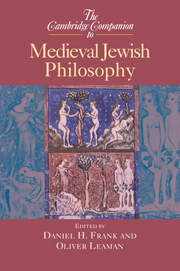Book contents
- Frontmatter
- PART I BACKGROUND AND CONTEXT
- PART II IDEAS, WORKS, AND WRITERS
- 4 Saadya and Jewish kalam
- 5 Jewish Neoplatonism
- 6 Judah Halevi and his use of philosophy in the Kuzari
- 7 Maimonides and medieval Jewish Aristotelianism
- 8 Maimonides and the sciences
- 9 Medieval Jewish political thought
- 10 Judaism and Sufism
- 11 Philosophy and kabbalah
- 12 Arabic into Hebrew
- 13 Philosophy in southern France
- 14 Conservative tendencies in Gersonides’ religious philosophy
- PART III THE LATER YEARS
- Guide to further reading in English
- Index
12 - Arabic into Hebrew
The Hebrew translation movement and the influence of Averroes upon medieval Jewish thought
from PART II - IDEAS, WORKS, AND WRITERS
Published online by Cambridge University Press: 28 May 2006
- Frontmatter
- PART I BACKGROUND AND CONTEXT
- PART II IDEAS, WORKS, AND WRITERS
- 4 Saadya and Jewish kalam
- 5 Jewish Neoplatonism
- 6 Judah Halevi and his use of philosophy in the Kuzari
- 7 Maimonides and medieval Jewish Aristotelianism
- 8 Maimonides and the sciences
- 9 Medieval Jewish political thought
- 10 Judaism and Sufism
- 11 Philosophy and kabbalah
- 12 Arabic into Hebrew
- 13 Philosophy in southern France
- 14 Conservative tendencies in Gersonides’ religious philosophy
- PART III THE LATER YEARS
- Guide to further reading in English
- Index
Summary
THE FIRST HEBREW TRANSLATIONS OF SCIENTIFIC WORKS
The translation into Hebrew of Arabic scientific and philosophic works in the thirteenth century and the first third of the fourteenth century made possible the flowering of science and philosophy among Jews in Western Europe in the late Middle Ages. The first scientific work to be translated from Arabic into Hebrew was an Arabic version of Aristotle's Meteorology. Samuel ibn Tibbon, the translator of Maimonides' Guide of the Perplexed, translated this work in 1210. This translation would be one of only three works of Aristotle to be translated into Hebrew directly from the Arabic translations, but it did not get the translation movement of scientific texts off to a running start. Ibn Tibbon himself, whose son Moses would become one of the most prolific and proficient of the Arabicto- Hebrew translators of scientific texts, showed surprisingly little interest in the translation of scientific texts. In fact, he claimed that he consented to translate the Meteorology only after the persistent entreaties of a learned scholar and dear friend, who had originally asked him to translate all Aristotle’s physical works, and when Ibn Tibbon refused, begged him to translate at least the Meteorology. But this was a poor choice. Unlike many of the Arabic translations of Aristotle’s works of the time, which could be found in fine copies of competent or even impressive translations, this text was available in seemingly corrupt copies of a poor Arabic paraphrase. To make sense of it Ibn Tibbon had to translate creatively, constantly comparing and relying on testimonia such as the commentaries of Alexander of Aphrodisias and Averroes.
- Type
- Chapter
- Information
- The Cambridge Companion to Medieval Jewish Philosophy , pp. 258 - 280Publisher: Cambridge University PressPrint publication year: 2003
- 5
- Cited by

